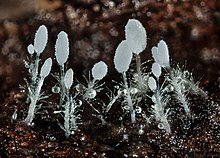Hirticlavula
| Hirticlavula | |
|---|---|
 |
|
 |
|
| Scientific classification | |
| Kingdom: | Fungi |
| Division: | Basidiomycota |
| Class: | Agaricomycetes |
| Order: | Agaricales |
| Family: | Clavariaceae |
| Genus: |
Hirticlavula J.H.Petersen & Læssøe (2014) |
| Species: | H. elegans |
| Type species | |
|
Hirticlavula elegans J.H.Petersen & Læssøe (2014) |
|
Hirticlavula is a fungal genus in the family Clavariaceae. It contains a single described species, Hirticlavula elegans. Formally described in 2014, the fungus has been collected from Norway and Denmark. H. elegans produces white fruit bodies up to 1.1 millimetres (0.043 in) in height. Each fruit body contains a fertile head atop a hairy stem. The fruit bodies grow directly from dead bark or wood, where they feed as saprotrophs. Both morphological and ecological details are distinctive when compared to other clavarioid fungi.
Hirticlavula elegans was described based on collections dating back to 1995. It was provisionally reported in 2009 in the proceedings of a 2008 conference, before being formally described in 2009 by Jens H. Petersen and Thomas Læssøe in an article in Karstenia, coauthored with Marie L. Davey. The specific name elegans is from the Latin meaning "elegant", and refers to how "pretty" the species's fruit bodies are. In Danish, the species has the common name hårkølle.Phylogenetic analysis suggests that within the Clavariaceae, Hirticlavula is a sister to the clade comprising Clavaria, Camarophyllopsis and Hodophilus.
Hirticlavula elegans produces white fruit bodies from 800 to 1100 micrometres (μm) in height. The robust and fertile head measures from 230 to 260 by 90 to 200 μm, while the hairy stem measures between 600 and 800 by 40 to 60 μm. The fruit bodies mostly retain their shape when dried, but do develop a cream tinge. The fruit bodies do not emerge from a sclerotium, but instead grow directly from the substrate.
...
Wikipedia
